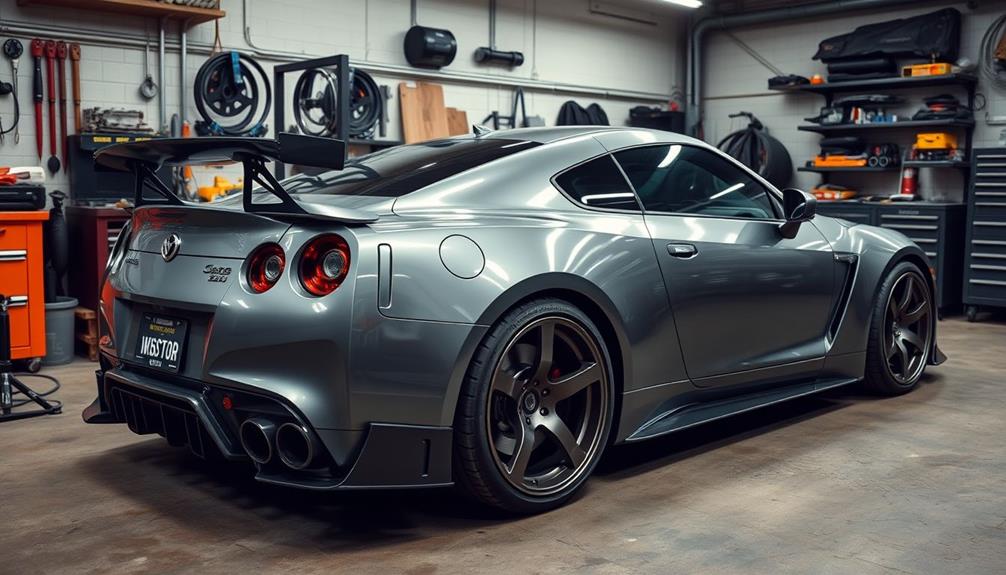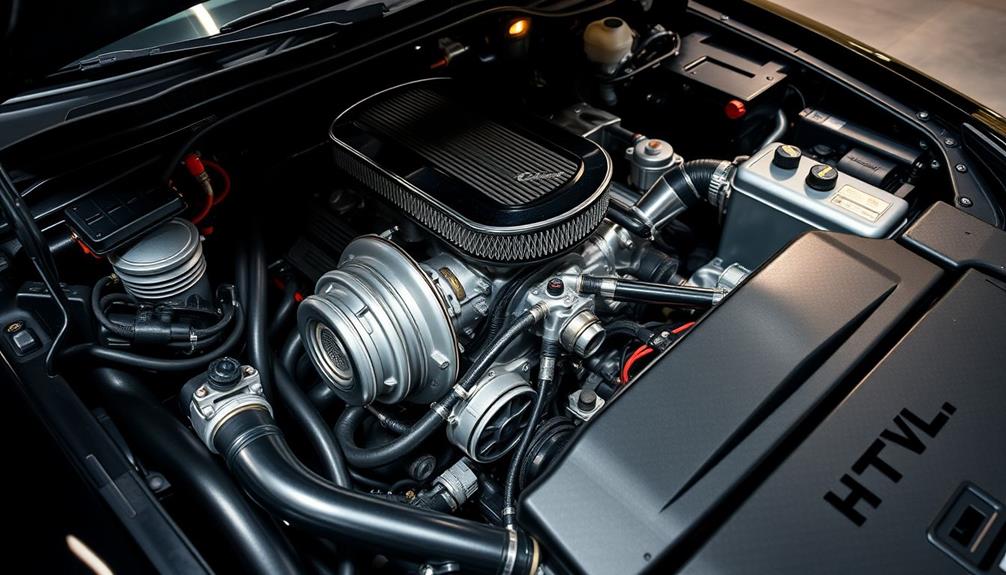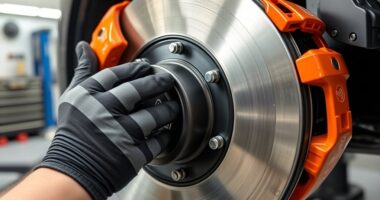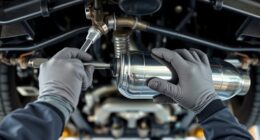Car tuning transforms your vehicle into a high-performance machine, focusing on enhancements that boost power, handling, and overall driving experience. Key areas include ECU remapping for optimized fuel delivery and ignition timing, which can add up to 50 horsepower. You'll want to contemplate aftermarket parts like turbochargers and upgraded exhaust systems for increased performance. Suspension upgrades, such as coilovers and sway bars, improve stability and handling. Don't forget brake enhancements to guarantee effective stopping power. Each modification elevates your ride, paving the way for an exhilarating journey. There's more to uncover about tuning options waiting for you.
Key Takeaways
- Car tuning involves enhancing vehicle performance through ECU remapping, optimizing fuel delivery and ignition timing for increased power.
- Essential modifications include upgrading air intake, exhaust systems, and installing turbochargers or superchargers for significant horsepower gains.
- Suspension tuning, such as adjustable coilovers and sway bars, improves handling stability and ride comfort for a better driving experience.
- Brake system upgrades, including high-performance pads and larger discs, enhance stopping power and ensure safety during high-performance driving.
- Regular alignment checks after modifications are crucial for optimal performance, improving grip and extending tire lifespan.
Understanding Car Tuning
When you think about car tuning, it's essential to understand that it goes beyond just making your vehicle look good; it greatly enhances its performance and handling.
Car tuning involves a range of performance upgrades and modifications that improve your driving experience, making your car not only faster but also more enjoyable to handle.
One key aspect of tuning is engine management, where techniques like ECU remapping optimize fuel delivery and ignition timing, boosting power and fuel efficiency.
You might also consider adding aftermarket parts like turbochargers or upgraded exhaust systems to further enhance engine performance.
Suspension tuning plays an important role too. By installing adjustable coilovers or sway bars, you can markedly improve handling stability and ride comfort, tailoring your car to your driving preferences.
Don't overlook aesthetic modifications either. Personalizing your car with body kits, rims, and lighting can make it stand out while ensuring that you adhere to safety regulations.
Ultimately, understanding car tuning means recognizing its potential to transform your vehicle into a high-performing, visually appealing machine that reflects your style and enhances your driving experience.
Tuning Stages Explained

When you start tuning your car, Stage 1 is where most people begin, focusing on ECU remapping to boost power with minimal effort.
Once you're ready for more, Stage 2 enhancements come into play, involving hardware upgrades like better exhaust systems and intercoolers.
Understanding these stages helps you make informed choices for performance while keeping your vehicle's integrity intact.
Stage 1 Overview
Stage 1 tuning kicks off the performance enhancement journey for your vehicle, focusing primarily on ECU remapping or chip tuning. This stage is all about software adjustments that can yield significant performance gains without heavy hardware modifications. You can expect power increases of up to 50 horsepower, depending on your vehicle.
Here are three common features of Stage 1 tuning:
- ECU Remapping: This involves altering the vehicle's engine management software to optimize performance.
- Air Intake and Exhaust Systems: By enhancing these components while retaining original catalytic converters, you boost airflow and engine efficiency.
- Plug-and-Play Devices: Devices like tuning boxes or the Pedal Commander make installation quick and easy.
Stage 1 tuning is considered a safe entry point because it generally maintains your vehicle's reliability while providing incremental performance improvements.
You won't need extensive planning or a huge investment to get started, making it an appealing option for those looking to enhance their driving experience without compromising legality or emissions compliance.
Stage 2 Enhancements
After you've explored the benefits of Stage 1 tuning, you might be ready to take your vehicle's performance to the next level with Stage 2 enhancements. At this stage, you'll delve into significant hardware modifications that elevate your engine's capabilities. Common upgrades include installing higher-flow fuel injectors and pumps to support increased power without major forced induction changes.
A key component of Stage 2 tuning is optimizing your exhaust system. By removing exhaust restrictions—often through sports catalysts or de-cat pipes—you improve exhaust flow, which is vital for maximizing performance.
Additionally, upgrading your air intake system can provide better airflow to your engine, further enhancing power output.
To fully capitalize on these modifications, a professional remap of your engine's ECU is essential. This remapping adjusts the vehicle's tuning parameters to match the new hardware, ensuring you get the most out of your enhancements.
With Stage 2 modifications, you can typically expect power increases ranging from 30 to 50 horsepower, depending on your specific vehicle and its baseline performance. Embrace these upgrades, and feel the exhilarating difference in your ride!
Essential Modifications and Upgrades

To truly access your car's potential, fundamental modifications and upgrades are key. These enhancements not only elevate engine performance but also improve handling and safety. For example, top-rated heat pumps can provide ideal comfort, which parallels how tuning can enhance driving experience.
Here are three significant areas to focus on:
- ECU Remapping: This performance upgrade can yield gains of up to 50 horsepower by refining fuel and timing settings, dramatically enhancing your vehicle's responsiveness.
- Exhaust System Upgrades: Upgrading to a high-flow exhaust system, including cat-back options, enhances exhaust flow and turbo efficiency. This modification boosts engine performance and contributes to a more aggressive sound.
- Suspension Upgrades: Investing in adjustable coilovers and reinforced sway bars is essential for improving handling. These suspension upgrades provide better cornering stability and overall driving dynamics, allowing you to tackle curves with confidence.
Don't overlook brake system enhancements, either. Larger rotors and high-performance pads are critical for effective stopping power as your vehicle's speed and power increase.
Supporting hardware upgrades like stronger clutches and performance tires are also necessary to manage increased torque and improve traction.
Engine Performance Enhancements

When it comes to boosting your car's performance, engine enhancements are a game-changer. One of the most effective methods is remapping the engine control unit (ECU). This adjustment optimizes fuel delivery and ignition timing, potentially adding up to 50 horsepower.
For an even bigger boost, consider upgrading to a turbocharger or supercharger. These components force more air into the engine, greatly increasing horsepower and torque for more exhilarating drives.
You can also enhance engine performance by installing high-performance air filters and exhaust systems. These upgrades improve airflow, allowing your engine to breathe better and respond more quickly.
Additionally, replacing stock fuel injectors with high-flow versions guarantees that your engine gets the fuel it needs to support these enhancements.
Utilizing performance components like forged pistons and upgraded camshafts can help you achieve higher compression ratios, leading to improved engine efficiency and more power overall.
Suspension and Handling Improvements

When you're looking to enhance your car's performance, understanding suspension types is essential.
Upgrading your suspension not only improves handling but also offers significant benefits in stability and responsiveness.
Plus, don't forget the importance of regular alignment checks after modifications to guarantee peak performance on the road.
Suspension Types Explained
Suspension systems play an essential role in how your car handles on the road, directly affecting both comfort and performance. Understanding the different types of suspension will help you choose the right mods for your tuning goals.
Here are three popular options:
- Coilovers: These adjustable suspension systems let you customize your ride height and stiffness, offering improved handling and comfort, making them a favorite for performance tuning.
- Air Suspension Systems: With the ability to adjust ride height and comfort levels, air suspension can switch between a softer daily ride and a firmer setup for spirited driving.
- Sway Bars: Also known as anti-roll bars, these help reduce body roll during cornering, enhancing stability and control, particularly in high-speed maneuvers.
Additional components like strut tower braces increase chassis rigidity, while upgraded dampers and lowering springs work together to improve shock absorption and handling.
Handling Enhancements Benefits
Enhanced handling is one of the most significant benefits you gain from upgrading your car's suspension system. By installing adjustable coilovers, you can customize your ride height and stiffness, which greatly improves handling characteristics. This adaptability allows you to tackle various driving conditions with ease.
Additionally, implementing upgrades such as airless paint sprayers can enhance the overall quality of your vehicle's finish, ensuring it looks as good as it performs. Adding sway bars reduces body roll during cornering, enhancing stability and enabling more aggressive driving without sacrificing safety.
Moreover, strut tower braces increase chassis rigidity, which sharpens handling response and minimizes flex during performance driving. This means you can experience better cornering precision, making every turn feel more controlled.
Enhanced suspension systems with upgraded dampers and pro bars also provide superior shock absorption and control, leading to a smoother driving experience.
Investing in these handling enhancements not only boosts your car's performance but also builds your confidence at high speeds. The result is a driving experience that's more enjoyable and engaging.
With these modifications, you'll notice a marked difference in how your car responds, making every journey more thrilling and dynamic. Don't underestimate the power of a well-tuned suspension; it can transform your ride completely.
Alignment Importance After Mods
After making modifications to your car's suspension, you can't overlook the vital role of proper alignment. Confirming your vehicle's wheel alignment is spot on is essential for enhancing handling performance and maintaining vehicle stability.
When you adjust components like coilovers or sway bars, the way your tires contact the road changes. Without a proper alignment, you risk uneven tire wear and compromised driving comfort.
Here are three key reasons why alignment is important after mods:
- Improved Performance: Proper alignment enhances grip, leading to better handling and overall performance.
- Reduced Tire Wear: Correct alignment helps in even tire wear, extending the life of your tires.
- Enhanced Steering Response: A well-aligned vehicle offers sharper steering response, making your driving experience more enjoyable.
Regular alignment checks should be part of your maintenance routine, especially after modifications.
It's best to have these adjustments performed by professionals using specialized equipment. This guarantees precision and compliance with manufacturer specifications, allowing you to fully enjoy the benefits of your suspension upgrades without sacrificing stability or safety.
Brake System Upgrades

Upgrading your brake system is one of the most effective ways to boost your vehicle's performance and safety. By investing in high-performance variants of brake pads, you can greatly enhance your stopping power and reduce brake fade during aggressive driving.
Larger brake discs improve heat dissipation, allowing for effective braking and minimizing the risk of overheating during extended use.
Consider installing stainless steel brake lines, as they offer improved pedal feel and response by reducing flex compared to standard rubber lines. This upgrade results in more precise braking control, which is vital when you need to stop quickly.
A performance brake booster can also make a big difference, increasing the pressure applied to the brake system for shorter stopping distances and a more responsive brake pedal.
Don't overlook ventilated and slotted rotors, either. These enhancements improve airflow and boost braking efficiency, especially in high-performance applications where consistent braking is essential.
Benefits of Car Tuning

Improving your brake system sets the stage for exploring the broader advantages of car tuning. When you tune your car, you're not just enhancing its looks; you're also notably improving its performance.
Here are three key benefits:
- Boost Engine Power: With adjustments to the engine control unit (ECU), you can increase your vehicle's power output by up to 50 horsepower. This translates into better acceleration and an overall thrilling driving experience.
- Increase Fuel Efficiency: Tuning can optimize your performance settings, potentially saving you 10-15% in fuel consumption. You'll enjoy longer drives without constantly worrying about refueling.
- Better Handling: Enhanced torque from tuning improves your vehicle's pulling capacity, making it more effective for towing or carrying heavy loads. This not only meets your performance needs but also guarantees more controlled and enjoyable handling on the road.
Car tuning not only enhances a vehicle's capabilities but also promotes engine durability and longevity.
Frequently Asked Questions
What Does a Car Tuning Include?
Car tuning includes performance mods like engine remapping and suspension upgrades, enhancing speed and handling. You'll also find aesthetic changes, brake enhancements, and supporting hardware improvements to boost safety and overall driving experience. Following a car tuning process, it is important to ensure that regular maintenance and servicing are carried out to keep the vehicle in optimal condition. This includes following the vehicle maintenance guide provided by the manufacturer to address any specific needs related to the modifications made. Proper upkeep will not only prolong the lifespan of the tuned components but also ensure the overall safety and performance of the vehicle.
What Does a Stage 3 Tune Include?
Ever wondered what a Stage 3 tune really involves? You'll immerse yourself in serious upgrades like forged pistons and high-performance fuel systems, while optimizing your ECU and enhancing suspension to handle that newfound power safely.
How Much Does Car Tuning Cost?
Car tuning costs vary considerably. You might spend around $300 for basic upgrades or up to $20,000 for extensive modifications. Consider your goals and budget when planning your tuning journey to maximize performance effectively.
What Is Stage 1 and Stage 2 Tuning?
Stage 1 tuning optimizes your engine's ECU for better fuel efficiency and power, while Stage 2 adds hardware upgrades to enhance performance. You'll notice increased horsepower and improved responsiveness with each stage.
Conclusion
In the world of car tuning, you're not just upgrading a vehicle; you're crafting a masterpiece. Think of it like sculpting: every modification chisels away at the ordinary, revealing a work of art. When you enhance your engine, fine-tune your suspension, or upgrade your brakes, you're creating a ride that's uniquely yours. Just like a sculptor finds beauty in stone, you'll discover the joy in every rev and turn, making your driving experience truly unforgettable.










